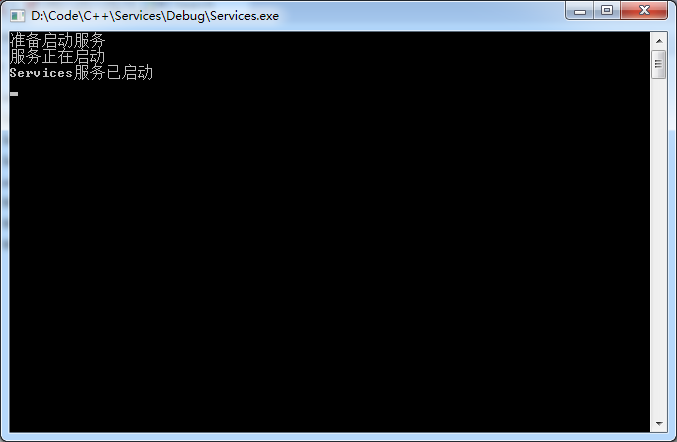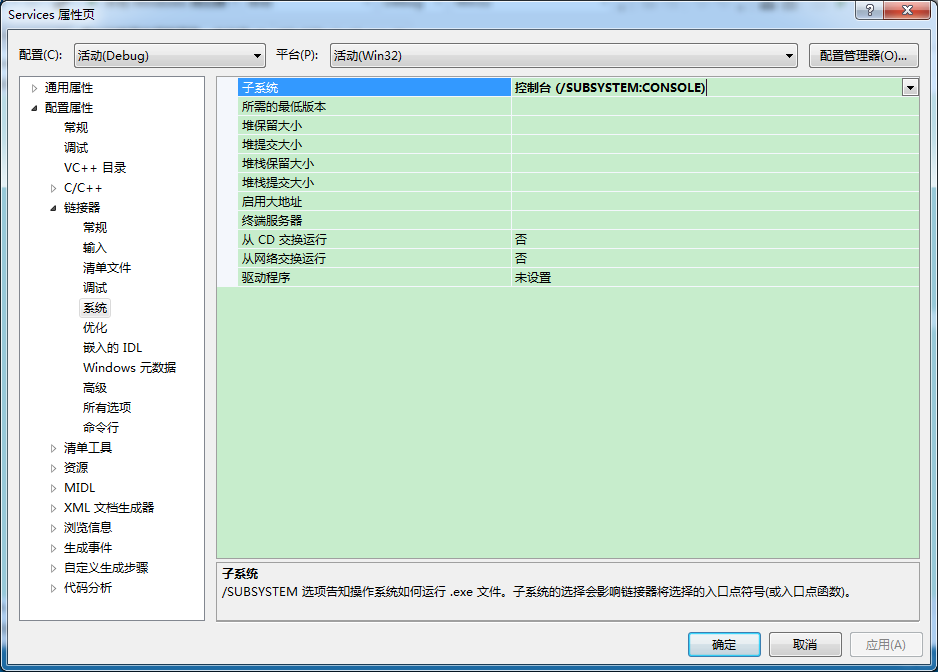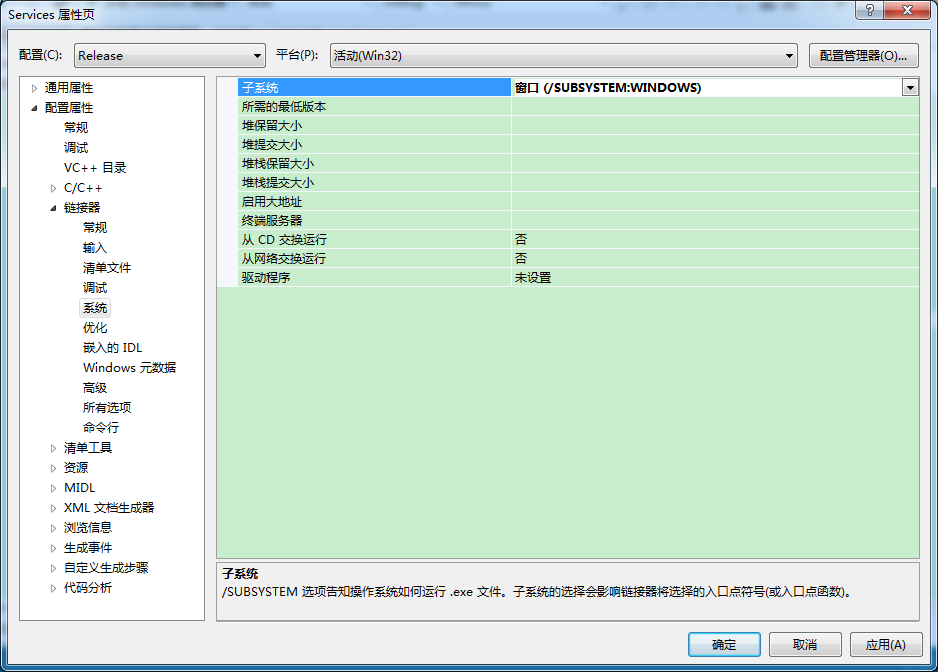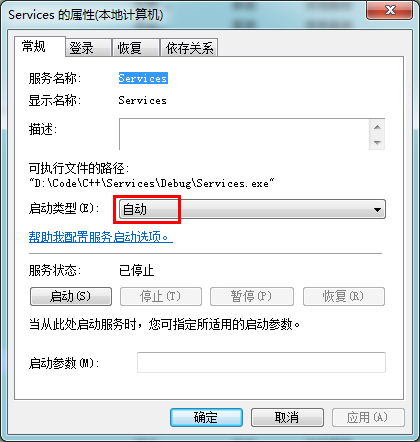伴随着研究Windows服务,逐渐掌握了一些小技巧,现在与大家分享一下。
将Windows服务转变为控制台程序
由于默认的Windows服务程序,编译后为Win32的窗口程序。我们在程序启动或运行过程中,如果想看到一些调试信息,那么就只能通过DebugView或者输出到日志的方式了。因为如果我们通过printf或者std::cout输出调试信息的话,Win32窗口程序是无法显示的。
此时,我们是多么怀念我们的经典的控制台程序啊,它可以很方便的将我们的调试信息输出出来,简直是太方便了。既然如此,那我们就让它一秒钟变格格吧,额,应该是一秒钟变控制台。
下面分享一下我的实现代码
#ifdef _DEBUG //Debug版本,直接输出到控制台 #define OUT(s) printf_s(s); #define OUT_LN(s) printf_s(s##"\r\n"); #else //非Debug版本,则输出到调试器,一般使用DebugView #define OUT(s) OutputDebugString(s); #define OUT_LN(s) OutputDebugString(s); #endif class CServicesModule : public ATL::CAtlServiceModuleT< CServicesModule, IDS_SERVICENAME > { public : DECLARE_LIBID(LIBID_ServicesLib) DECLARE_REGISTRY_APPID_RESOURCEID(IDR_SERVICES, "{0794CF96-5CC5-432E-8C1D-52B980ACBE0F}") HRESULT InitializeSecurity() throw() { return S_OK; } //服务启动 HRESULT Load(); //服务停止 HRESULT UnLoad(); HRESULT Run(_In_ int nShowCmd = SW_HIDE) throw() { HRESULT hr = S_OK; OUT_LN("准备启动服务"); hr = Load(); if(hr) { OUT_LN("启动服务失败"); return hr; } OUT_LN("Services服务已启动"); hr = ATL::CAtlServiceModuleT< CServicesModule, IDS_SERVICENAME >::Run(nShowCmd); hr = UnLoad(); OUT_LN("Services服务正常退出"); return hr; } }; CServicesModule _AtlModule; // #ifndef _DEBUG //非Debug版本,编译为Win32程序 extern "C" int WINAPI _tWinMain(HINSTANCE /*hInstance*/, HINSTANCE /*hPrevInstance*/, LPTSTR /*lpCmdLine*/, int nShowCmd) { return _AtlModule.WinMain(nShowCmd); } #else //Debug版本,编译为控制台程序 int _tmain(int argc, _TCHAR* argv[]) { return _AtlModule.WinMain(SW_SHOW); } #endif HRESULT CServicesModule::Load() { OUT_LN("服务正在启动"); return 0; } HRESULT CServicesModule::UnLoad() { OUT_LN("服务正在停止"); return 0; }
通过_DEBUG宏来区分是否编译成控制台程序。
当指定编译Debug版本时,可以将程序编译为控制台程序,通过RegServer注册服务,然后直接运行服务exe程序,这样通过printf输出的信息,就可以在控制台上显示了,如下图。
当指定编译Release版本时,将程序编译为Win32程序,通过Service注册服务,通过服务管理器管理服务的运行和停止。
当然,这还不是全部,还有一个地方需要设置,下面分别是Debug和Release下的设置
当然,还有一种更简单的方法,可以将Debug和Release模式下的“子系统”项修改为“未设置”。这样编译器在编译链接时,会根据代码中的入口函数,自动将代码链接为对应的程序。如图

注册服务为自动启动服务
注册服务的流程已经在前面的博客玩转Windows服务系列——Debug、Release版本的注册和卸载,及其原理中有介绍,这里就不再多说。重点说一下创建服务的Windows API CreateService。
如下是MSDN中的API声明
SC_HANDLE WINAPI CreateService(
_In_ SC_HANDLE hSCManager,
_In_ LPCTSTR lpServiceName,
_In_opt_ LPCTSTR lpDisplayName,
_In_ DWORD dwDesiredAccess,
_In_ DWORD dwServiceType,
_In_ DWORD dwStartType,
_In_ DWORD dwErrorControl,
_In_opt_ LPCTSTR lpBinaryPathName,
_In_opt_ LPCTSTR lpLoadOrderGroup,
_Out_opt_ LPDWORD lpdwTagId,
_In_opt_ LPCTSTR lpDependencies,
_In_opt_ LPCTSTR lpServiceStartName,
_In_opt_ LPCTSTR lpPassword
);
参数太多,不一一介绍,详细介绍可以查看MSDN。
其中第六个参数,代表启动方式
dwStartType [in] The service start options. This parameter can be one of the following values. Value Meaning SERVICE_AUTO_START 0x00000002 A service started automatically by the service control manager during system startup. For more information, see Automatically Starting Services. SERVICE_BOOT_START 0x00000000 A device driver started by the system loader. This value is valid only for driver services. SERVICE_DEMAND_START 0x00000003 A service started by the service control manager when a process calls the StartService function. For more information, see Starting Services on Demand. SERVICE_DISABLED 0x00000004 A service that cannot be started. Attempts to start the service result in the error code ERROR_SERVICE_DISABLED. SERVICE_SYSTEM_START 0x00000001 A device driver started by the IoInitSystem function. This value is valid only for driver services.
SERVICE_AUTO_START 表示自动启动,这个参数就是我们想要的。
SERVICE_BOOT_START 也属于自动启动,但是只能用于内核服务。
SERVICE_DEMAND_START 手动启动,这是目前服务的默认启动方式。
SERVICE_DISABLED 禁止启动。
SERVICE_SYSTEM_START 属于自动启动,但只能用于内核服务。
所以,我们只需要在调用CreateService方法时,设置dwStartType参数为SERVICE_AUTO_START即可实现服务自动启动,而CreateService的其他参数,则参考现在的调用参数
::CreateService( hSCM, m_szServiceName, m_szServiceName, SERVICE_ALL_ACCESS, SERVICE_WIN32_OWN_PROCESS, SERVICE_AUTO_START, SERVICE_ERROR_NORMAL, szFilePath, NULL, NULL, _T("RPCSS\0"), NULL, NULL);
接下来,我们只需要重载命令行解析方法,添加参数用于确定是否自动启动即可。
注册服务时设置服务的依赖关系
设置服务的依赖关系仍然要看CreateService服务,这次我们看倒数第三个参数lpDependencies
lpDependencies [in, optional] A pointer to a double null-terminated array of null-separated names of services or load ordering groups that the system must start before this service. Specify NULL or an empty string if the service has no dependencies. Dependency on a group means that this service can run if at least one member of the group is running after an attempt to start all members of the group. You must prefix group names with SC_GROUP_IDENTIFIER so that they can be distinguished from a service name, because services and service groups share the same name space.
lpDependencies是一个指针,指针指向了一个以’\0\0’结尾,并且以’\0’分割开的字符串,由’\0’分割开的字符串为依赖服务的名字。
比如,如果设置当前服务依赖RPCSS 和DependTest服务的,则可以这样调用CreateService方法
::CreateService( hSCM, m_szServiceName, m_szServiceName, SERVICE_ALL_ACCESS, SERVICE_WIN32_OWN_PROCESS, SERVICE_AUTO_START, SERVICE_ERROR_NORMAL, szFilePath, NULL, NULL, _T("RPCSS\0DependTest\0"), NULL, NULL);
由于字符串自身会以’\0’结尾,所以字符串内容中的结尾处只需写一个’\0’。
接下来,我们只需要重载命令行解析方法,添加参数用于确定是否自动启动即可
添加自定义命令行参数
添加自定义命令行参数 Auto, 用来设置启动方式为自动启动, 并且给Service参数添加依赖项,实现代码如下
// Services.cpp : WinMain 的实现 #include "stdafx.h" #include "resource.h" #include "Services_i.h" using namespace ATL; #include <stdio.h> #ifdef _DEBUG #define OUT(s) printf_s(s); #define OUT_LN(s) printf_s(s##"\r\n"); #else #define OUT(s) OutputDebugString(s); #define OUT_LN(s) OutputDebugString(s); #endif class CServicesModule : public ATL::CAtlServiceModuleT< CServicesModule, IDS_SERVICENAME > { public : DECLARE_LIBID(LIBID_ServicesLib) DECLARE_REGISTRY_APPID_RESOURCEID(IDR_SERVICES, "{0794CF96-5CC5-432E-8C1D-52B980ACBE0F}") HRESULT InitializeSecurity() throw() { // TODO : 调用 CoInitializeSecurity 并为服务提供适当的安全设置 // 建议 - PKT 级别的身份验证、 // RPC_C_IMP_LEVEL_IDENTIFY 的模拟级别 // 以及适当的非 NULL 安全描述符。 return S_OK; } //服务启动 HRESULT Load(); //服务停止 HRESULT UnLoad(); // Parses the command line and registers/unregisters the rgs file if necessary bool ParseCommandLine( _In_z_ LPCTSTR lpCmdLine, _Out_ HRESULT* pnRetCode) throw(); //注册服务 BOOL Install() throw(); //重写此方法,主要是为了调用重写的Install方法 inline HRESULT RegisterAppId(_In_ bool bService = false) throw() { if (!Uninstall()) return E_FAIL; CServicesModule::UpdateRegistryAppId(TRUE); CRegKey keyAppID; keyAppID.Open(HKEY_CLASSES_ROOT, _T("AppID"), KEY_WRITE); CRegKey key; key.Create(keyAppID, CServicesModule::GetAppIdT()); key.DeleteValue(_T("LocalService")); key.SetStringValue(_T("LocalService"), m_szServiceName); // Create service if (!Install()) return E_FAIL; return S_OK; } HRESULT Run(_In_ int nShowCmd = SW_HIDE) throw() { HRESULT hr = S_OK; OUT_LN("准备启动服务"); hr = Load(); if(hr) { OUT_LN("启动服务失败"); return hr; } OUT_LN("Services服务已启动"); hr = ATL::CAtlServiceModuleT< CServicesModule, IDS_SERVICENAME >::Run(nShowCmd); hr = UnLoad(); OUT_LN("Services服务正常退出"); return hr; } private: _TCHAR dependServices[256]; DWORD size; DWORD dwStartType; }; CServicesModule _AtlModule; // #ifndef _DEBUG extern "C" int WINAPI _tWinMain(HINSTANCE /*hInstance*/, HINSTANCE /*hPrevInstance*/, LPTSTR /*lpCmdLine*/, int nShowCmd) { return _AtlModule.WinMain(nShowCmd); } #else int _tmain(int argc, _TCHAR* argv[]) { return _AtlModule.WinMain(SW_SHOW); } #endif HRESULT CServicesModule::Load() { memset(dependServices, 0, sizeof(dependServices)); dwStartType = SERVICE_DEMAND_START; OUT_LN("服务正在启动"); return 0; } HRESULT CServicesModule::UnLoad() { OUT_LN("服务正在停止"); return 0; } // Parses the command line and registers/unregisters the rgs file if necessary bool CServicesModule::ParseCommandLine( _In_z_ LPCTSTR lpCmdLine, _Out_ HRESULT* pnRetCode) throw() { if (!CAtlExeModuleT<CServicesModule>::ParseCommandLine(lpCmdLine, pnRetCode)) return false; TCHAR szTokens[] = _T("-/"); *pnRetCode = S_OK; LPCTSTR lpszToken = FindOneOf(lpCmdLine, szTokens); while (lpszToken != NULL) { if (WordCmpI(lpszToken, _T("Service"))==0) { lpszToken += _tcslen(_T("Service")); //循环读取依赖项 while (true) { LPCTSTR lpszTokenBegin = lpszToken; while(isprint(*lpszToken) && *lpszToken != _T(' ') && *lpszToken != _T('-') && *lpszToken != _T('/')) { lpszToken++; } DWORD tokenSize = (lpszToken - lpszTokenBegin); memcpy_s(dependServices + size, sizeof(dependServices) - size, lpszTokenBegin, tokenSize * sizeof(_TCHAR)); size += tokenSize; dependServices[size] = _T('\0'); if(tokenSize) { size++; } while(isprint(*lpszToken) && *lpszToken == ' ') { lpszToken++; } if((*lpszToken == _T('\0') || *lpszToken == _T('-') || *lpszToken == _T('/'))) { dependServices[size + 1] = _T('\0'); break; } } *pnRetCode = this->RegisterAppId(true); if (SUCCEEDED(*pnRetCode)) *pnRetCode = this->RegisterServer(TRUE); return false; } //设置启动类型 if (WordCmpI(lpszToken, _T("Auto"))==0) { dwStartType = SERVICE_AUTO_START; } lpszToken = FindOneOf(lpszToken, szTokens); } return true; } BOOL CServicesModule::Install() throw() { if (IsInstalled()) return TRUE; // Get the executable file path TCHAR szFilePath[MAX_PATH + _ATL_QUOTES_SPACE]; DWORD dwFLen = ::GetModuleFileName(NULL, szFilePath + 1, MAX_PATH); if( dwFLen == 0 || dwFLen == MAX_PATH ) return FALSE; // Quote the FilePath before calling CreateService szFilePath[0] = _T('\"'); szFilePath[dwFLen + 1] = _T('\"'); szFilePath[dwFLen + 2] = 0; SC_HANDLE hSCM = ::OpenSCManager(NULL, NULL, SC_MANAGER_ALL_ACCESS); //创建服务、根据命令行设置启动方式,设置依赖关系 SC_HANDLE hService = ::CreateService( hSCM, m_szServiceName, m_szServiceName, SERVICE_ALL_ACCESS, SERVICE_WIN32_OWN_PROCESS, dwStartType, SERVICE_ERROR_NORMAL, szFilePath, NULL, NULL, dependServices, NULL, NULL); if (hService == NULL) { ::CloseServiceHandle(hSCM); return FALSE; } ::CloseServiceHandle(hService); ::CloseServiceHandle(hSCM); return TRUE; }
自定义命令行参数演示
注册服务时使用如下命令行
Services.exe -Auto -service CryptSvc RPCSS DcomLaunch
注册后,效果如下

系列链接
玩转Windows服务系列——Debug、Release版本的注册和卸载,及其原理
玩转Windows服务系列——无COM接口Windows服务启动失败原因及解决方案
玩转Windows服务系列——Windows服务启动超时时间







